Hindu famous (authentic) (sacred) pilgrimage sites in India – Part 2
Namaste friends, how are you doing today? Welcome to #BhagavanBhakthi website / blog.
Bhagavan Lord Sri Krishna blessings to you and your family!
In this website / blog, you will always learn about #Hinduism #Sanskrit language.
Also subscribe to my YouTube channel from this link #BhagavanBhakthi to view videos about #Hinduism #Sanskrit language.
Just before moving towards to know about “Hindu famous (authentic) (sacred) pilgrimage sites in India – Part 2“, let us know few basic information.
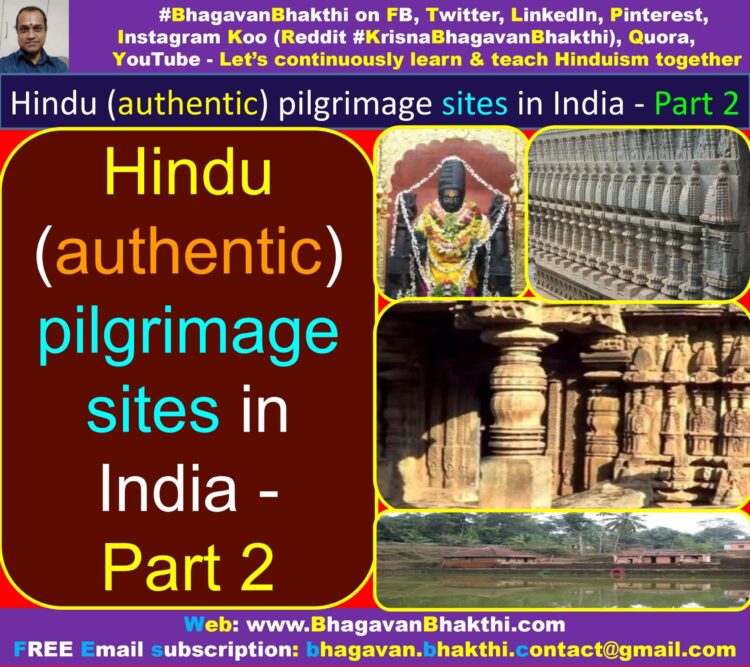
I urge to the readers to read this post completely and also to read the other posts connected with this post, to understand about all the pilgrimage sites of India with authenticity as per Hindu Puranas.
Note : Please note that, as said in the part 1, this below information is based on an authentic grantha (Hindu text) which was written around 500 years ago.
And this is completely free from the today’s Babas, Swamy’s, modern temples, money oriented temples, etc. information.
For few web visitors, these pilgrimage places may look like unknown places.
But, all these places are genuine pilgrimages places as given in Hindu Puranas and other granthas (texts).
There was a great and divine saint (Sanyasi) in Udupi, in South India called as Guru Sri Vadiraja Tirtha nearly 500 years ago.
He had travelled all over India and had written a grantha (Hindu text) called as ‘Tirtha Prabandha‘ (pilgrimage places information).
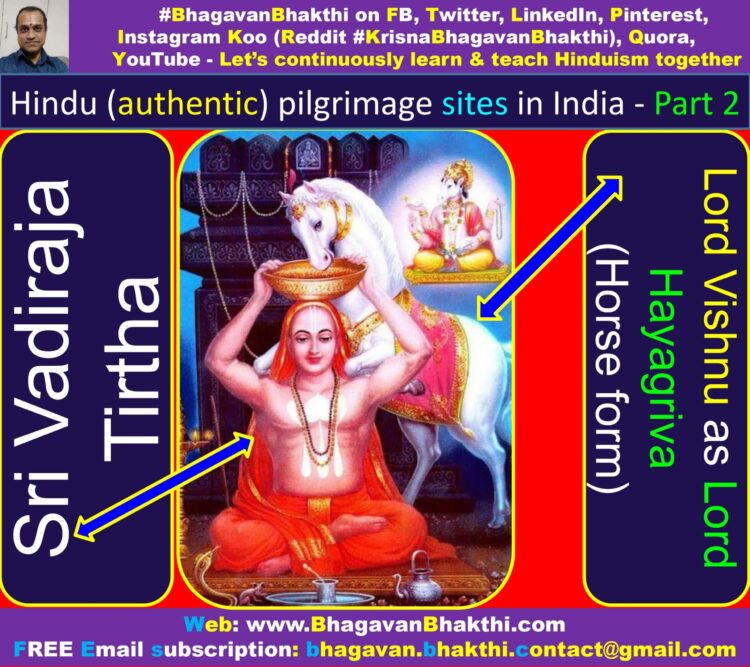
In this grantha (Hindu text), he has given information about the various pilgrimage places around the India.
Guru Sri Vadiraja Tirtha visited the holy pilgrimage places around India starting from Udupi (Karnataka) in a clockwise direction, through:
West —> North —> East —> Sourthen directions.
Finally Guru Sri Vadiraja Tirtha reached a place called today’s Thiruvananthapuram and submitted his holy grantha (Hindu text) at the lotus feet of Lord Sri Ananthapadmanabha Swamy in Kerala.
Now, let us know those pilgrimage places basic information.
Let us continue from “Hindu (authentic) pilgrimage sites in India – Part 1“, that is, let us start from the Paschima (Western) side from where we left in Part 1 as given below:
Paschima Prabanda (India’s Western side pilgrimage places part 2 information) is as given below:
(This covers south-western parts of the authentic temples of India)
Harihara : This divine temple is located at the Davanagere state in Bengaluru – Mumbai highway (Karnataka) on the banks of Tunga-Bhadra river.
It is said that the demon named Guha appeased the creator of the universe Lord Brahma and got a boon from him.
As per this boon, neither Lord Hara (Shiva) nor Lord Hari (Vishnu) could destroy him single handedly.
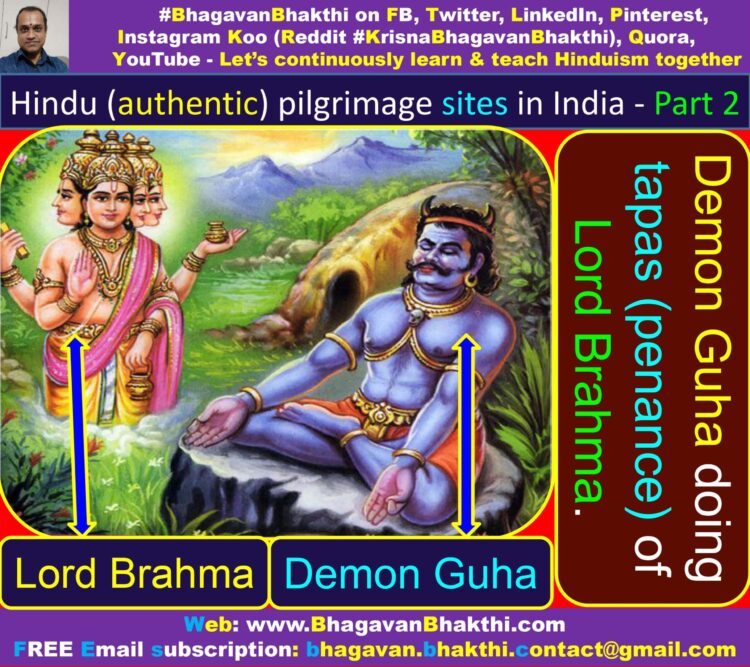
The demon Guha started torturing the Devatas (Demigods) in the Swarga Loka (Lord Indra’s place) and also for the human beings on the earth.
Thus, it became difficult for everyone to withstand his havoc.
As both Lord Hara (Shiva) and Lord Hari (Vishnu) could not destroy him on their own, they had to unite and take the form of ‘Harihara‘ to destroy the demon Guha.
Lord Hari (Vishnu) and Lord Hara (Shiva) are seen in the same idol inside Garbhagudi (sanctum sanctorum).
Lord Hara (Shiva) is on the right side wearing Rudraksha, Crown and Trishula in the hand.
While Lord Hari (Vishnu) is on the left side with Chakra on one hand and showering blessings on the other hand.
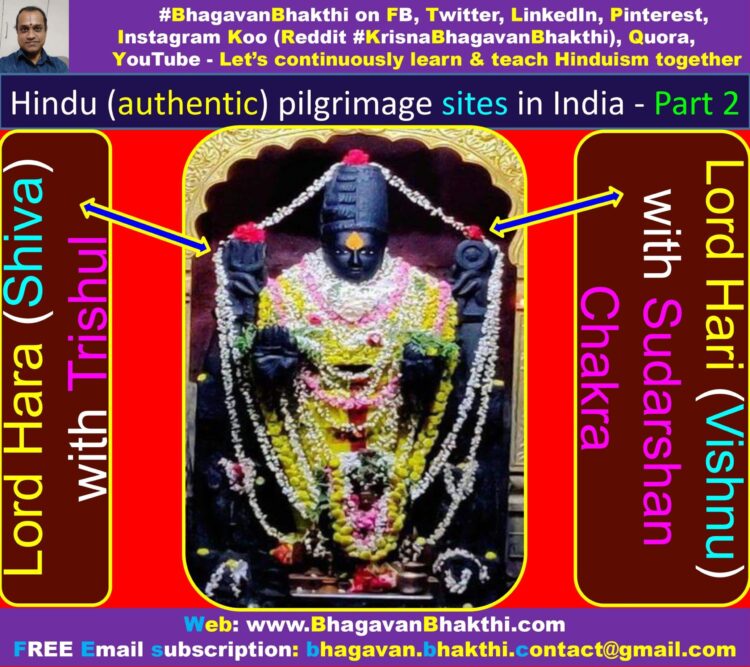
Ashwattha Narayana (Bidarahalli) : Guru Sri Vadiraja Tirtha explains the glory of ‘Ashwattha Vriksha’ (Peepal tree) on the banks of river Tunga-Bhadra.
Guru Sri Vadiraja Tirtha defines one need not visit Sri Rama Setu or Badri or Gaya or Pushkara or Prayaga etc. to get the blessings of Lord Hari (Vishnu)
But instead, just by visiting this ‘Ashwattha Vriksha’ and praying to Lord Narayana (Vishnu) is enough to get Sri Hari (Vishnu) complete blessings.
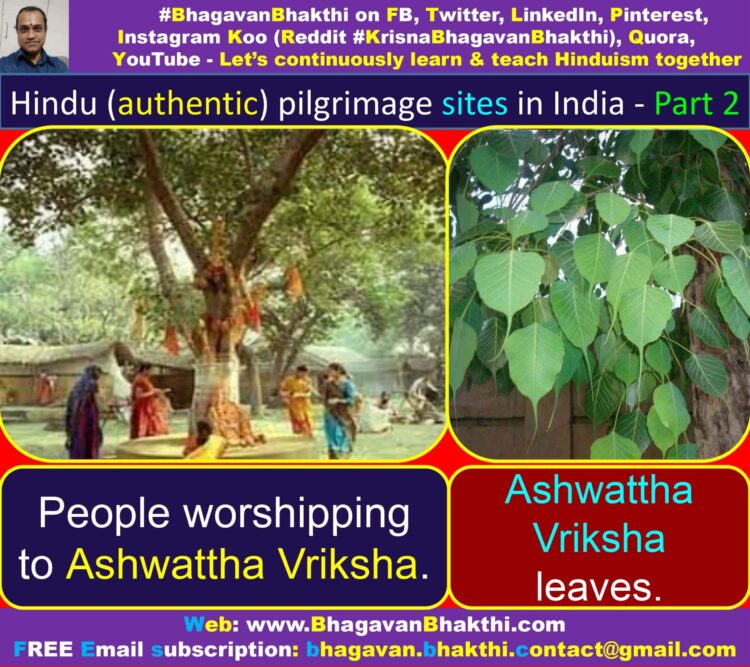
Someshwara (Bidarahalli) : This divine Kshetra is on the banks of Tunga-Bhadra river at Bidarahalli in Dharwad district of Karnataka.
There are temples of Lord Narasimha, Lord Venugopala and other deities here along with the ‘paada’ (Lotus foot) of Lord Ashwattha Narayana and Lord Vishnu.
सोमेश्वराय सितभूतिविकस्वराय | प्रेमप्रवृद्धगिरिजाहृदि भास्वराय |
तुङ्गोल्लसत्पवनपावितवंशपल्ली | माङ्गल्यहेतुचरिताय नमः शिवाय ||
Meaning of the above shloka : O Lord Someshwara! my namaskaras to you Lord Shiva!
You are the one who is enchanting due to white vibhuti, one who shines in the love-filled heart of girijaa.
And you are the one who has a history of granting auspiciousness to the village of Vamshapalli (Now this place is called as Bidarahalli) which is purified by the divine winds of the river Tunga-Bhadra.
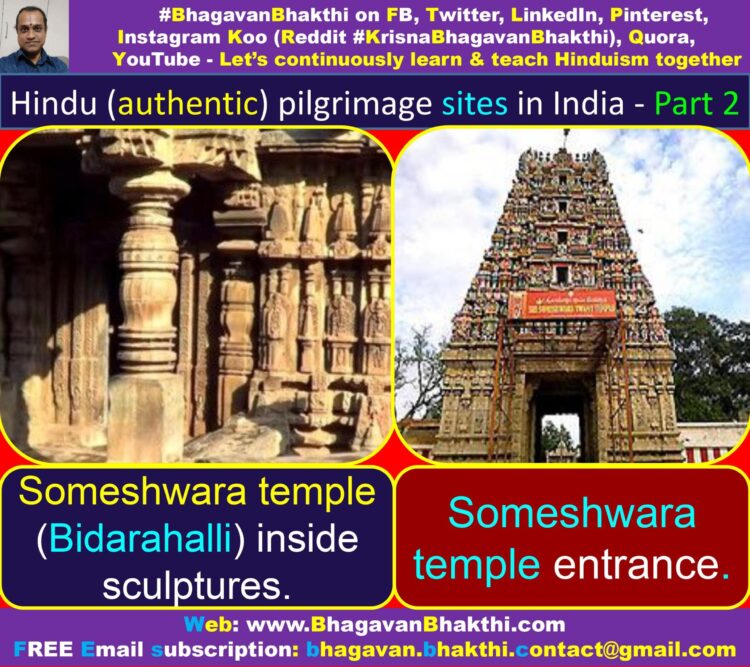
Keshava (Bankapura ): There is a Lord Keshava temple in a place called as Bankapura.
This temple is just off NH4 between Haveri (10 kms) and Hubli (60 kms).
Here an amazing point to be noted is that, this place called Bankapura was an area of the demon Bakasura.
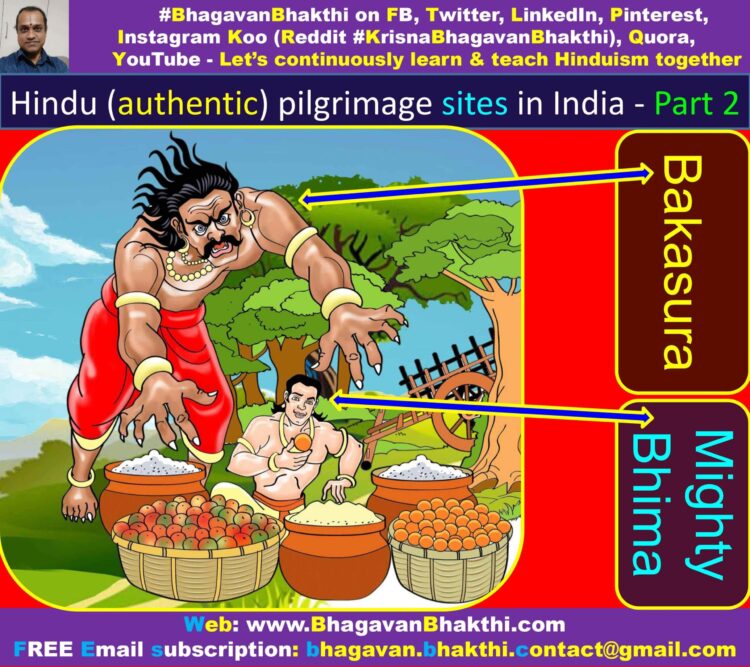
This same place later became the premises of Ghatotkacha (Bhima’s son).
When the divine Pandavas escaped from the Wax Palace, through a tunnel, the other end of the tunnel opened at this same place of Bankapura.
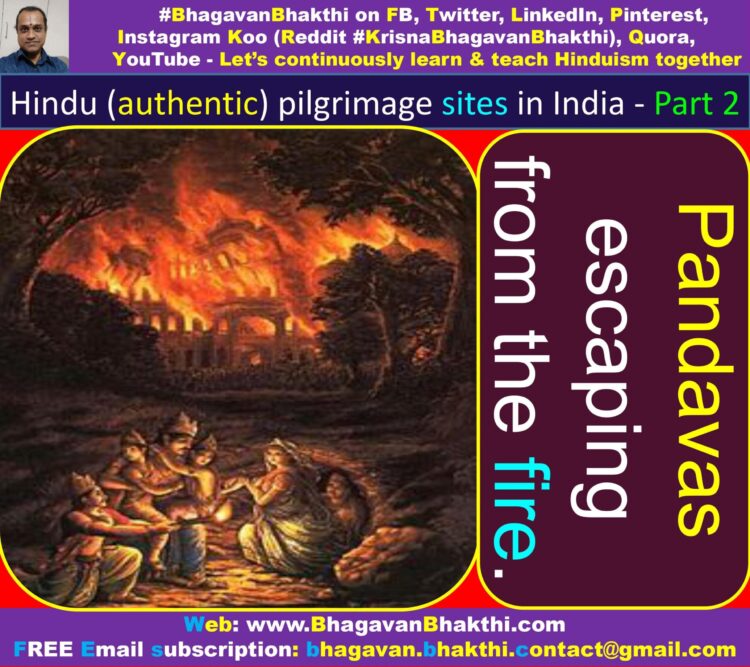
It is believed that Pandavas stayed here for some time and consecrated this deity of Lord Sri Keshava.
Varada river : The Varada river originates near ‘Varadamoola‘ at Sagara in Karnataka.
Varada river starts near a place called Ikkeri in Karnataka and after flowing as an independent river for some distance, later it merges into the Tunga-Bhadra.
The river joins the Tungabhadra River at Galaganath.
स्मरदाश्रितदुष्कर्मगुरुदाहविदारिणीम् | वरदां हरिदासेष्टवरदानरतां भजे ||
Meaning of the above shloka : I worship river Varada, which destroys the dushkarmas (misdemeanor) of its devotees that accrue in the form of extreme misery
And will forever grant boons that are liked by Sri Hari dasas (Lord Vishnu devotees).
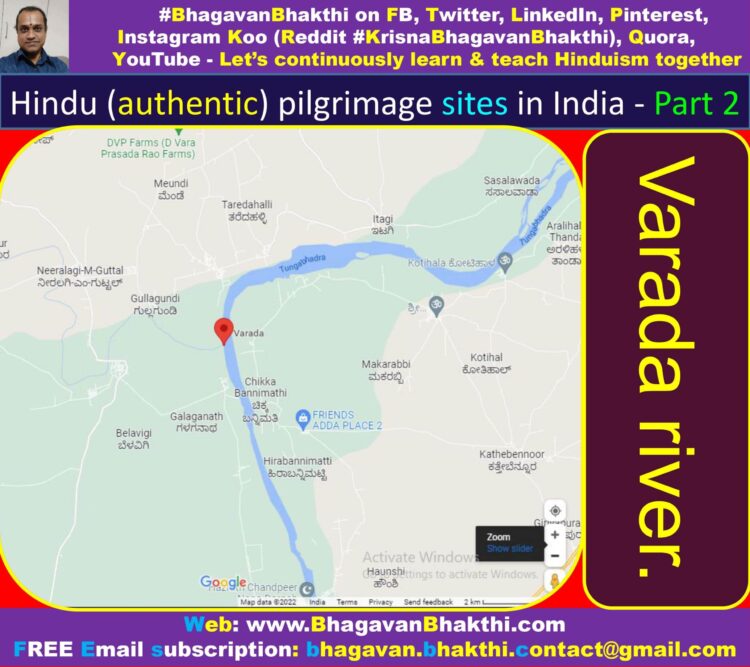
Madhukeshwara (Banavasi) : This divine temple is 25 kms away from a place called Sirsi in Karnataka.
The ever divine Madhukeshwara temple is located in a place called Banavasi, an ancient town on the borders of the Uttara Kannada and Shivamogga districts.
The temple is dedicated to Lord Shiva. It is believed to have been built during the reign of the Kadamba dynasty.
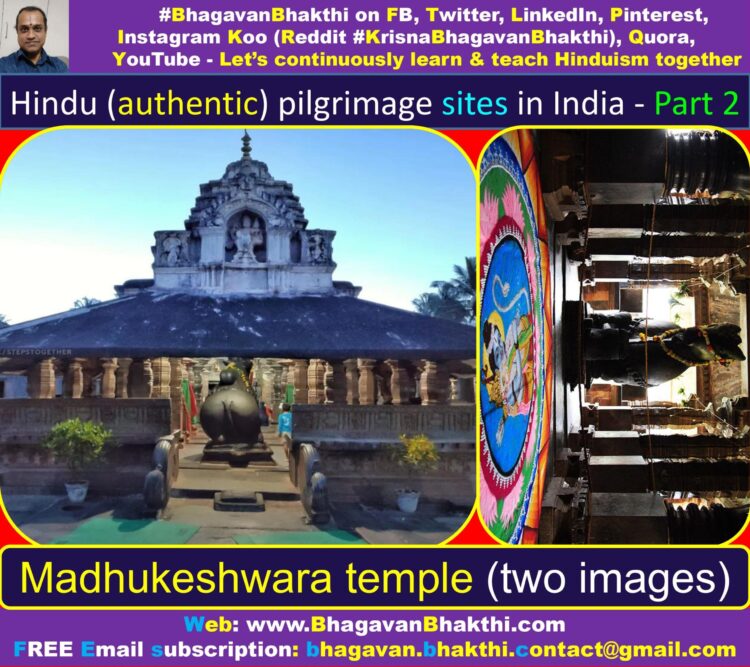
Dharmaganga (Dharma) river : Guru Sri Vadiraja Tirtha took a holy dip here and explains the holiness of the river.
हे धर्मगङ्गे पापौघभङ्गे तुङ्गतरङ्गिणि | चेतो मदीयं सद्धर्मकर्मण्येव स्थिरं कुरु ||
Meaning of the above shloka : O Dharmaganga river! You are the one who burns away heaps of sins, you are the one who is full of excellent waves.
Please ensure my mind is always rooted firmly in activities that are satvika dharma in nature.
This Dharmaganga (Dharma) river is a tributary of the river Varada and merges with it in Hanagal taluk of Karnataka.
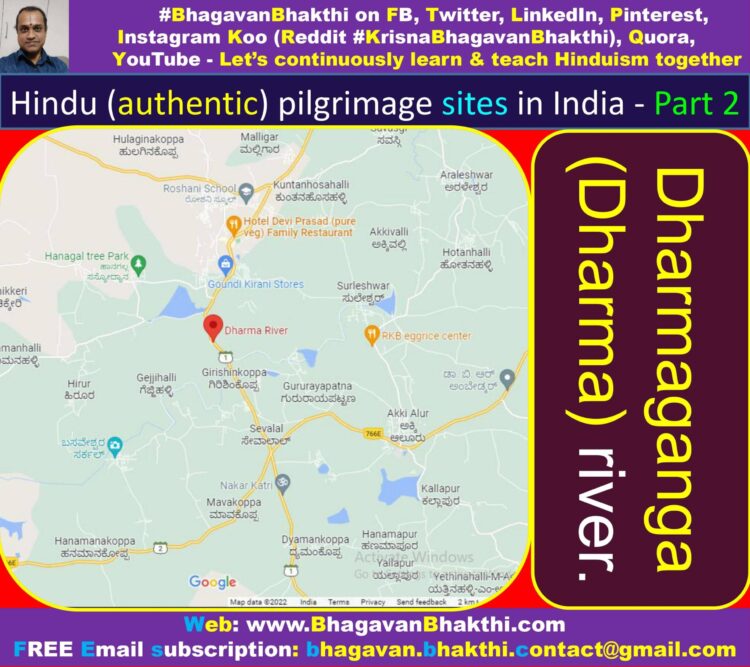
Shalmali river : Shalmali river joins the today’s Arabian sea near Gokarna.
Guru Sri Vadiraja Tirtha describe water is little salty on normal days and it become sweet on the eve of Gangashtami (Birthday of Goddess Ganga Devi).
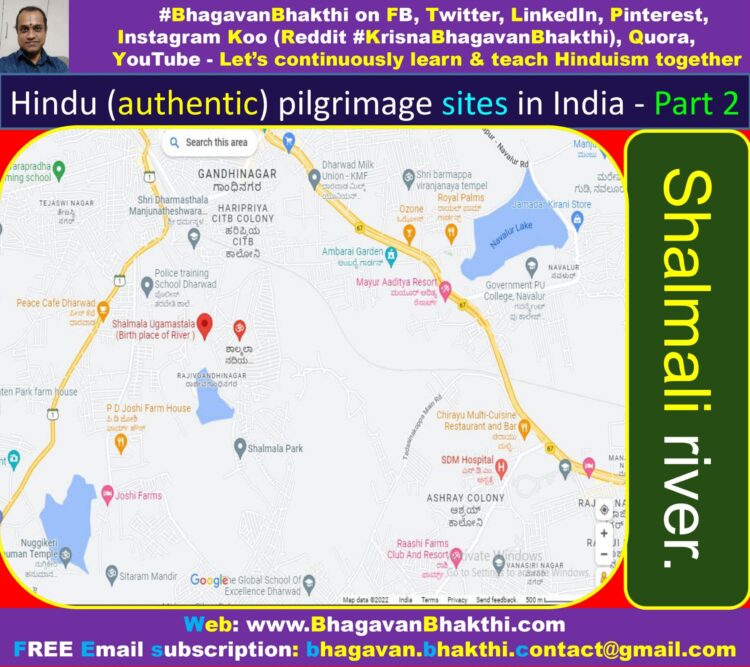
Sonda Kshetra : This divine place is approximately 20 kms from Sirsi town of Karnataka.
Guru Sri Vadiraja Tirtha describes the Lord Trivikrama temple and Dhavala Ganga.
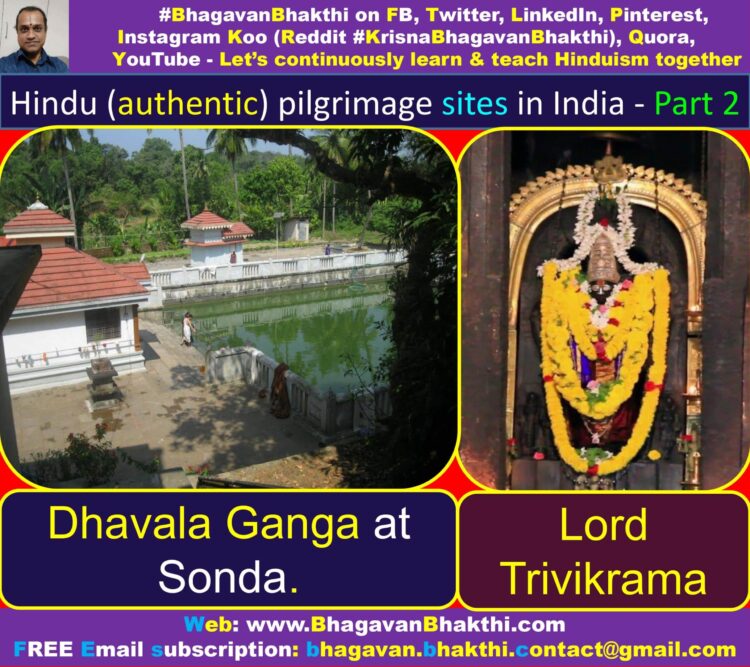
The ruler of Swadi (A place in Karnataka) requested Guru Sri Vadiraja Tirtha to construct a temple as there existed no Lord Vishnu temple at that place.
Guru Sri Vadiraja Tirtha asked the king to start construction of a temple.
When people questioned Guru Sri Vadiraja Tirtha about the deity,
he told them that the deity is of Lord Sri Trivikrama (Lord Vamana / Vishnu) would come to Sode (A place in Karnataka) from Uttara Badri (Badrinath in the Himalayas).
Guru Sri Vadiraja Tirtha told them that the deity is being worshipped by Sri Madhwacharya and the same was seen by him when he visited him and Lord VedaVyasa in Badrinath.
It is believed that the deity was brought to Sode (A place in Karnataka) by Sri Bhutaraja (Future Lord Shiva / Rudra).
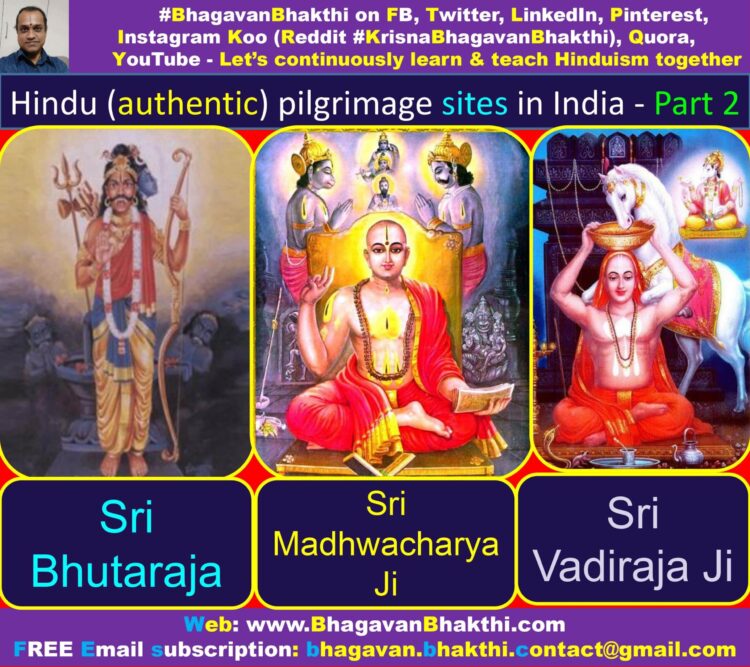
Sri Bhutaraja started bringing the entire Garbha Gudi (sanctum sanctorum) of the temple from Badrinath.
The structure is in the form of a stone chariot.
On the way, he is supposed to have been stopped by a demon.
But, Sri Bhutaraja used one of the wheels of the stone chariot to destroy the demon and made it on time to Sode.
Even in today’s time, one can find that the stone chariot structure housing the deity in the temple has just three wheels as compared to the four wheels.
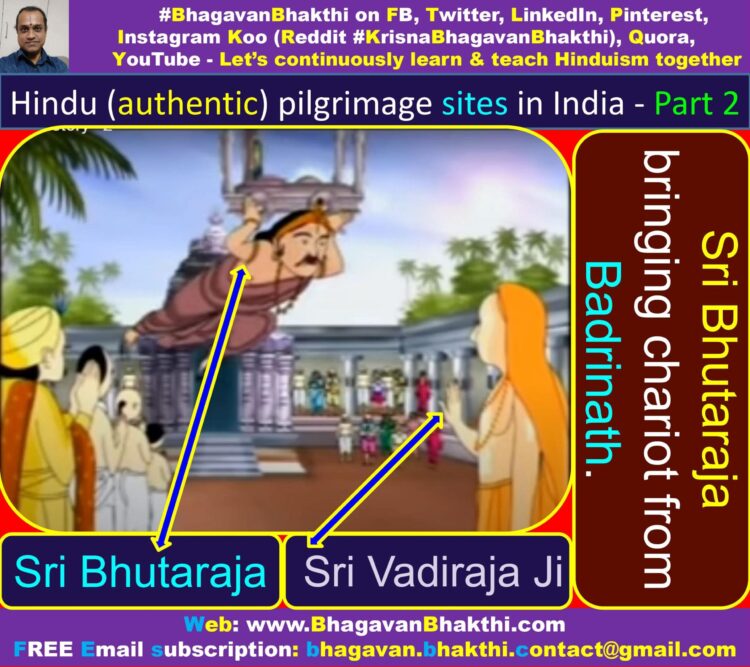
Devotees visiting Sode (A place in Karnataka) must definitely visit this temple and observe the unique stone chariot with three wheels.
Dhavala Ganga : This is a sacred tank (pond) in the Sode Kshetra and those who perform seva (serve), should take bath in Dhavala Ganga before commencing the seva (serve).
It is believed that this tank has all the holy and sacred rivers within it.
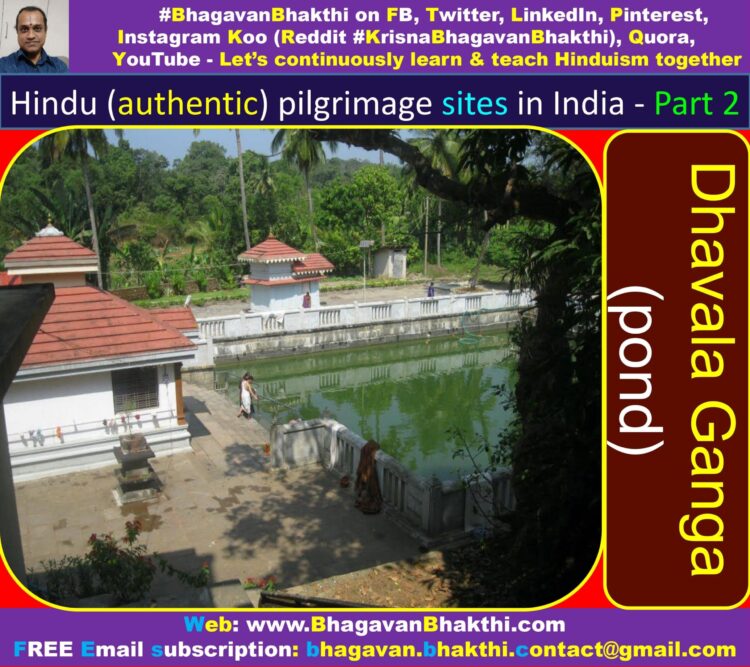
Manjuguni Venkatesha (Venkataramana) Kshetra : Manjuguni is a place located at a distance of 26 kms from Sirsi in Karnataka.
This divine temple here is dedicated to Lord Venkateshwara (Vishnu) and Goddess Padmavati.
According to “Sri Venkatesha Mahatmya”, the founder of this temple is ”Sri Tirumala Yogi” a saint.
During winter, this place will be covered by thick fog and hence this place called by the name “Manjuguni”.
In Sanskrit Manjuguni means ‘a place covered with thick fog‘.
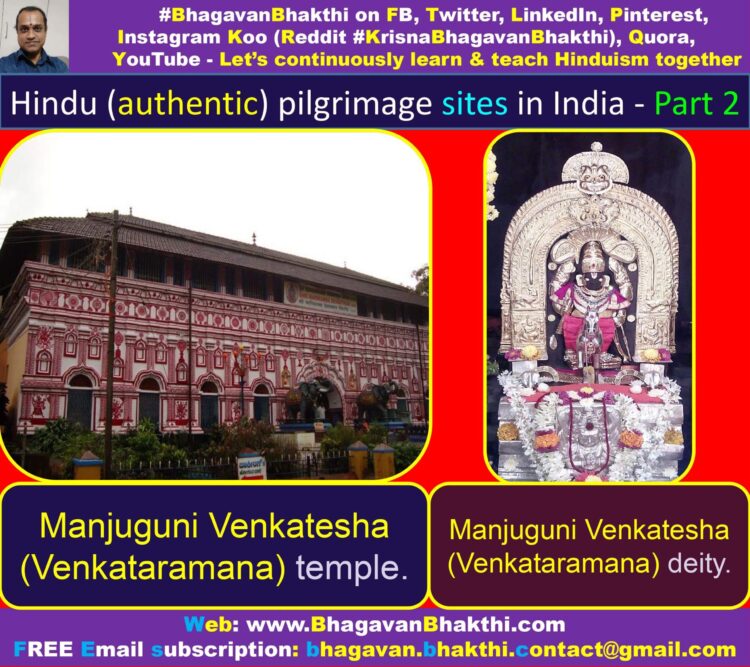
Yena Bhairava Kshetra : This divine temple is located in Kumta Taluk of Karwar district in Karnataka.
According to the local legend, Lord Shiva entered the cave as being driven away by Bhasmasura.
Water drops are falling on Lord Shiva’s head even though there is no water source found nearby.
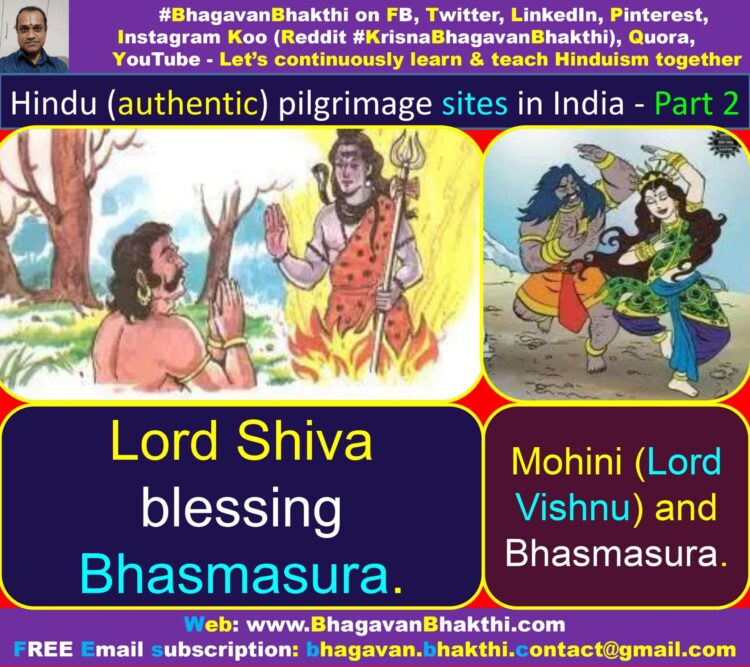
Gokarna Kshetra : Lord Shiva is in Gokarna in the form of ‘Atma Linga’.
The temple is located on today’s Arabian sea shore.
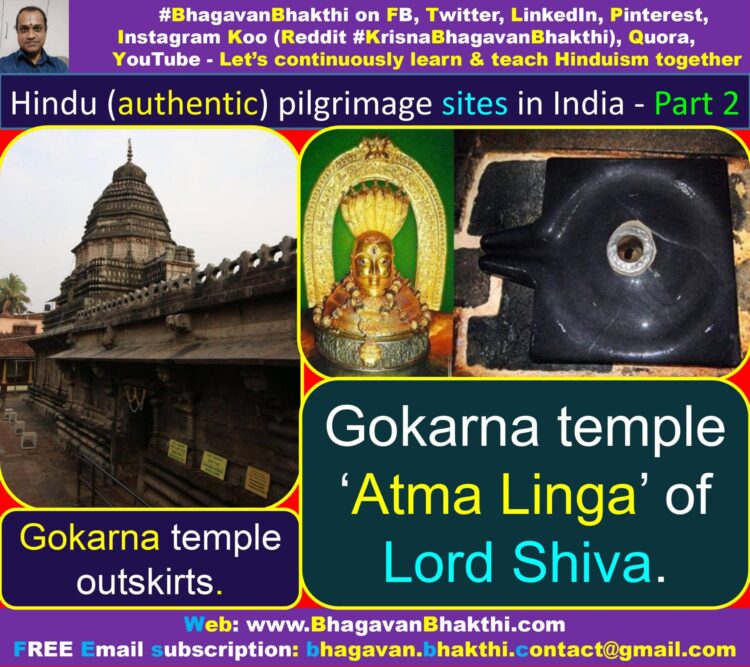
During Treta Yuga period, the demon King of Lanka, Ravana reaches Kailasha and performs rigorous penance to get the “Atma Linga” from Lord Shiva.
Ravana does this, as his mother expresses a keen desire to worship the ‘Atma Linga’ of Lord Shiva.
After a long and hardship penance, Lord Shiva gives the “Atma Linga” to Ravana as a boon and instructs Ravana as below:
“Carry it to home (To Lanka) by walk. Also, he should never place it on the earth (surface) even for a short while.”
“Failing this, the Linga will get eternally embedded at the place were he broke his commands.”
As Ravana was coming near Gokarna, Lord Vishnu who had known well that Ravana was punctual in performing his periodical rites called ‘Sandhyavandana’, hides Sun with his Sudarshana Chakra (Disc).
Thinking that it was time to perform the evening rites of ‘Sandhyavandana’,
Ravana finds a Brahmin boy and asked him to hold the ‘Atma Linga’ in his hand till he came back after finishing the rites of ‘Sandhyavandana’.
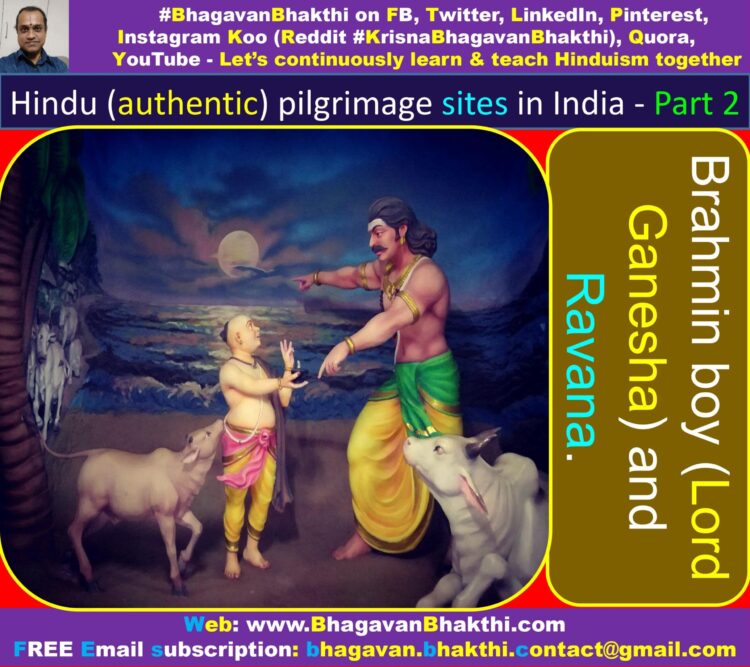
Lord Ganesha (The Brahmin boy in disguise) agreed to hold the ‘Atma Linga’ but on one condition.
He (Lord Ganesha disguised as a Brahmin boy) will do so till he will be able to bear the weight of Linga and that thereafter he will call Ravana three times.
And if he (Ravana) failed to come to him by then, he will place the Linga on the earth (surface).
Later, Lord Ganesha calls Ravana three times when he was performing his rites of ‘Sandhyavandana’ and places the Linga on the earth (surface) and he gets vanished from that place.
The ‘Atma Linga’ at once gets firmly entrenched in the earth (surface).
Ravana learned that he had been tricked by the Devatas (Demigods).
The depressed demon King Ravana was deeply agitated and tried to pull up the ‘Atma Linga’.
But the ‘Atma Linga’ did not budge even a little bit.
It resulted in his throwing the coverings of the ‘Atma Linga’ to Dhareshwara, Gunavanteshwara, Murdeshwara and Shejjeshwara temples.
The demon King Ravana was unable to lift the ‘Atma Linga’ from the ground again and called Lord Shiva Linga as Mahabala (you are too strong).
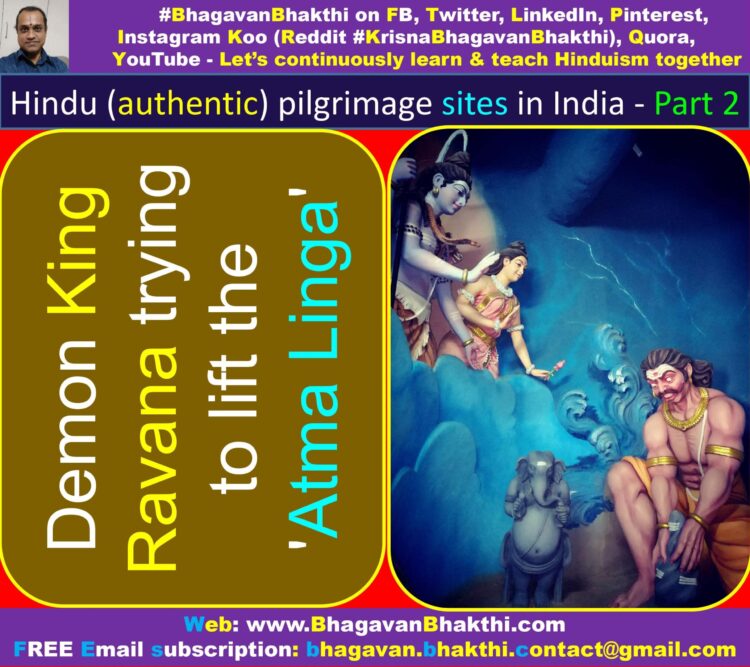
And ever since the ‘Atma Linga’ is known as ‘Mahabaleshwara‘.
Kolhapur Mahalakshmi : One of the most divine temples of Sri Maha Lakshmi Devi is located around 58 kms from Miraj town in today’s Maharashtra.
In ‘Skanda Purana’ this place is known as ‘Karaveerapura’.
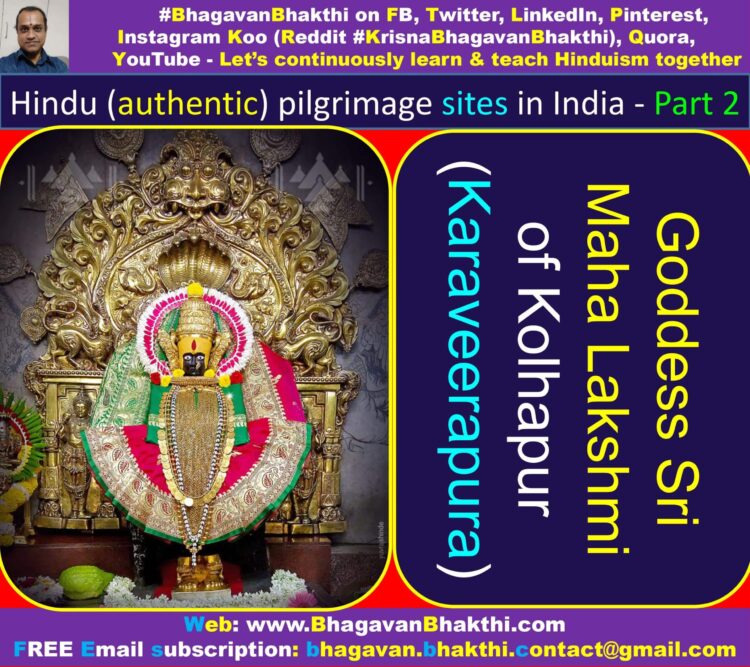
The Hindu legend says that, Sri Maha Lakshmi Devi came down from Vaikuntha (Most divine abode of Lord Vishnu) and stayed here in this place.
This is because of the anger caused by Maharishi Bhrigu, when he kicks Lord Vishnu on his ‘Vaksha Sthala’ (chest part).
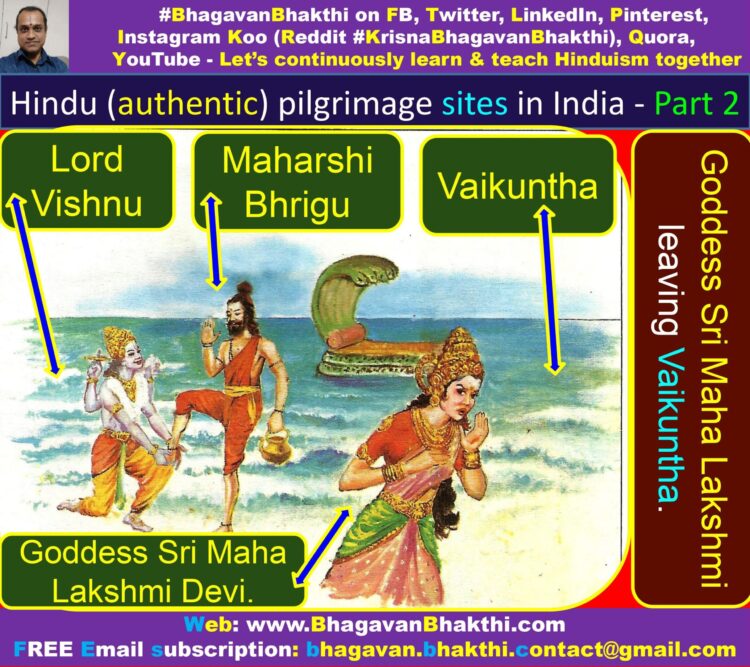
The deity of the Goddess Sri Maha Lakshmi Devi is made of gemstone and is considered to be at least 5000 to 6000 years old. It weighs about 40 kilos.
Note : After when Goddess Sri Maha Lakshmi Devi goes to this place of Kolhapur, Lord Vishnu goes to Tirupati (Tirumala) as Lord Venkatesha (Srinivasa / Balaji).
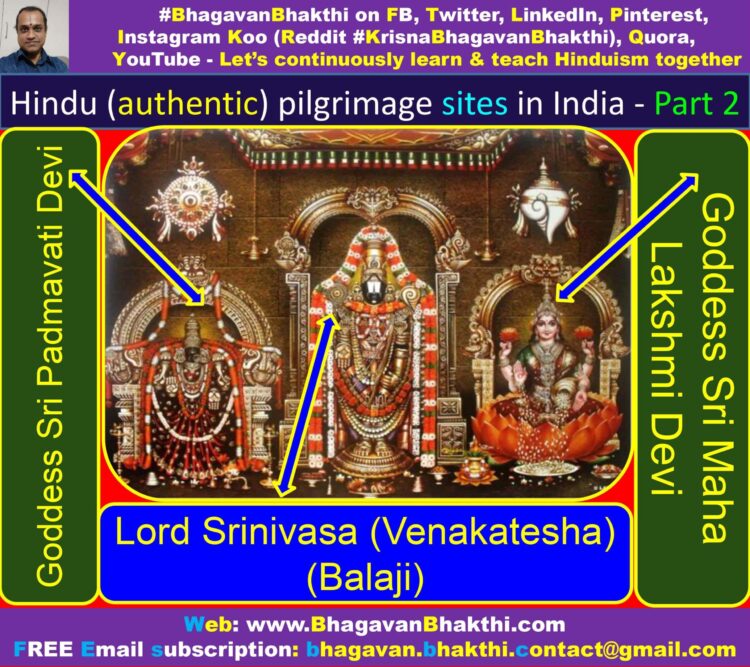
Tapti (Tapati) river : This holy river originates from ‘Vindhya Hills’ and merges in today’s Arabian sea near Surat town (Gujarat).
Guru Sri Vadiraja Tirtha describes Tapti (Tapati) river as she clears all the sin of the Sajjanas (Devotees).
Note : In Sanskrit, Tapti river is known as ‘Taapa nadi‘ (Very hot river).
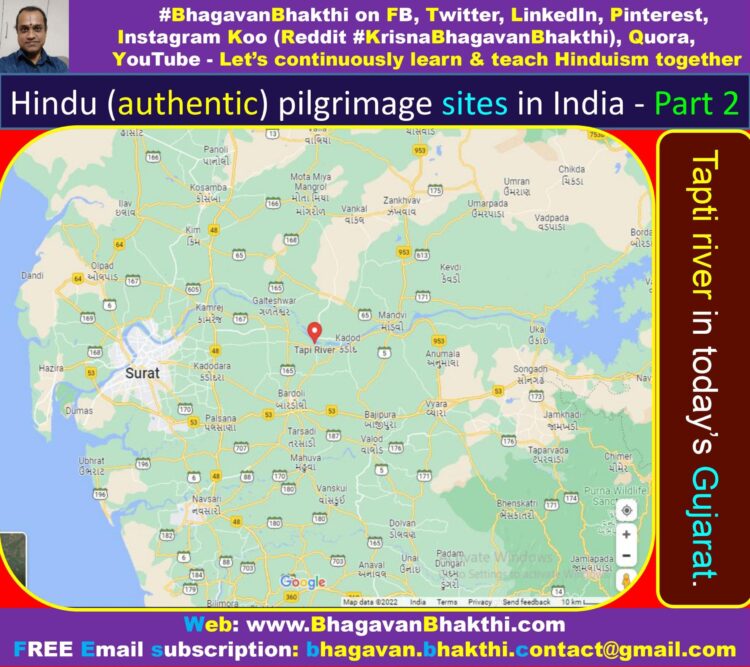
Narmada river : Sins garnered in 100 births are just cleared by just taking one holy dip in this Narmada river.
The Narmada river originates from ‘Mekala Giri’ of Amara Karnataka village (Today it is called as Amarkantak) is situated in between Vindhya Hills and Satpura Hills.
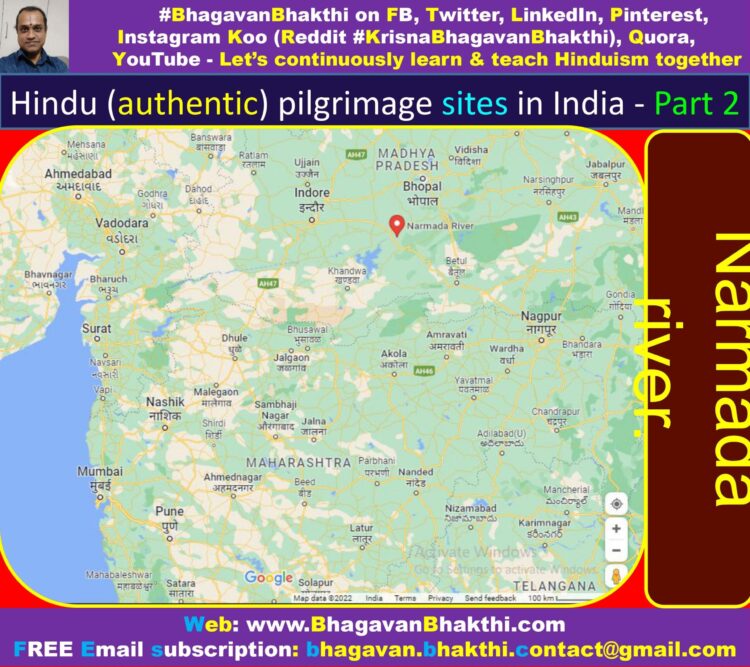
Prabhas (Prabhasa) Kshetra : This revered place is also known as ‘Somanath’.
River Kapila, River Saraswati and River Hiranya join each other before they join today’s Arabian sea.
Somnath temple is also known as Prabhasa (Prabhas) Patan and this shrine is eternal.
Somnath is one of the 12 jyotirlinga shrines of Lord Shiva.
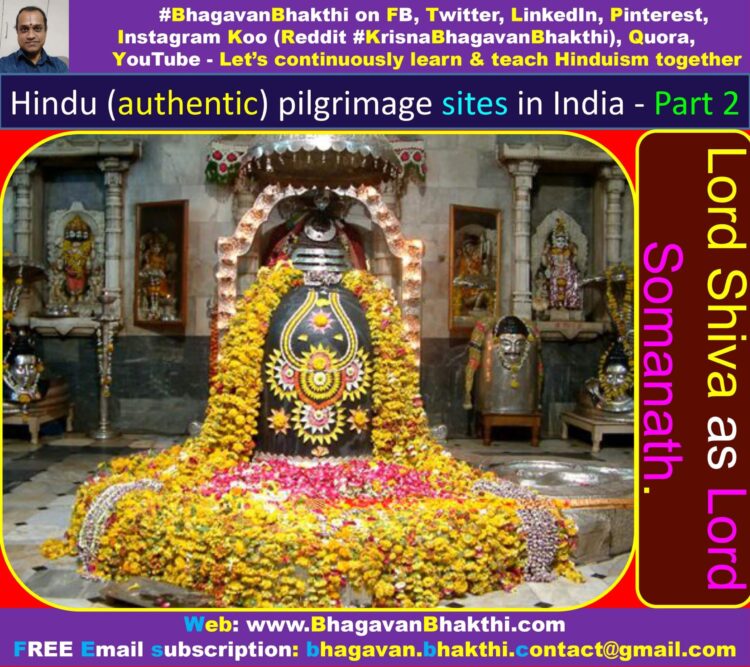
Lord Chandra (Moon God) was the first one to receive the benefic boon of Sri Somnath of Saurashtra, the Lord Shiva pilgrimage, Agni Tirtha and Surya Tirtha.
Then Lord Chandra built a beautiful golden temple and added a glorious ‘JyotirLinga’ in it, the first of its kind in India.
Lord Chandra (Moon God) is also called Soma (Som).
For this reason, this ‘JyotirLinga’ has become famous as Somnath (Somanatha / Somanath).
Lord Chandra (Moon God) looks very bright here. Therefore, this place is also known as “Prabhasapattana” (A Sanskrit word).
In Sanskrit Prabhasapattana (Prabhas Pattan / Patan) = Prabhasa + Pattana = Highly bright + Town.
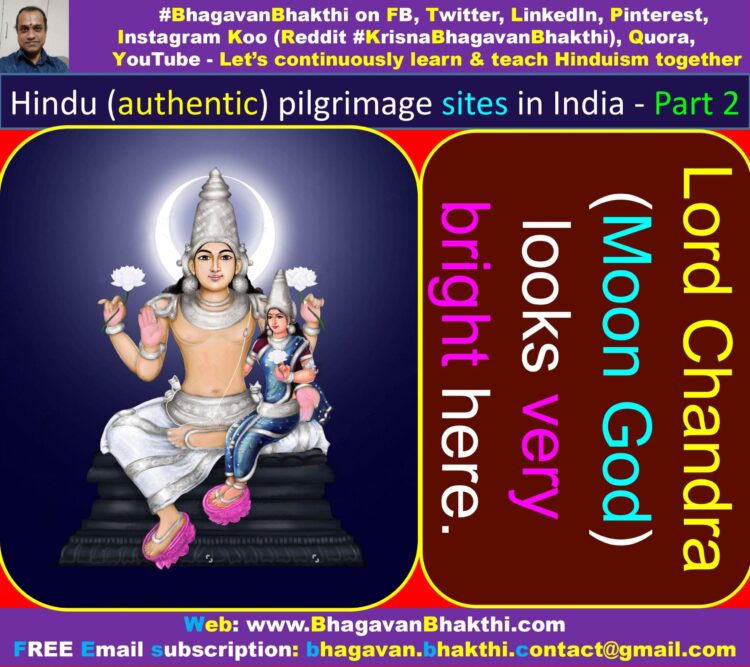
Banaganga (Banganga) river : It is 3 kms away from Somnath temple.
The spring was created when Lord Krishna threw the arrow set on his leg by Jaravyadha.
This river is in today’s Rajasthan. Banganga River, is 240 km long tributary of Gambhir river in India.
This Banganga river originates from the hills of Aransar and Bairath (Virat Nagar) in Jaipur region of Rajasthan state.
And confluences with Yamuna near Fatehabad in Agra district of Uttar Pradesh state.
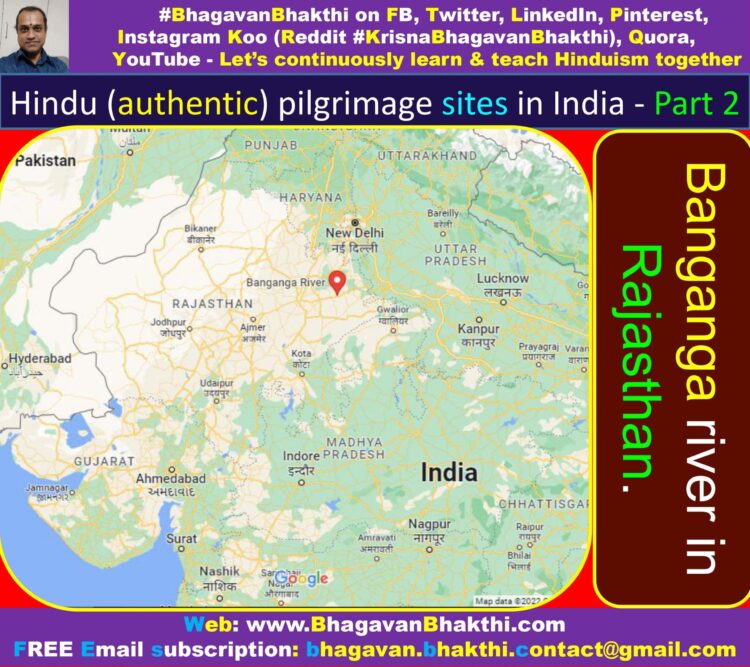
Dwarakapuri (Dwaraka) (Dwarka) : After defeating Kushasura,
Lord Krishna created a new town called Dwaraka (Dwarka) over the ‘Kushali Dweepa‘ (An island) through the Devata architecture Vishwakarma.
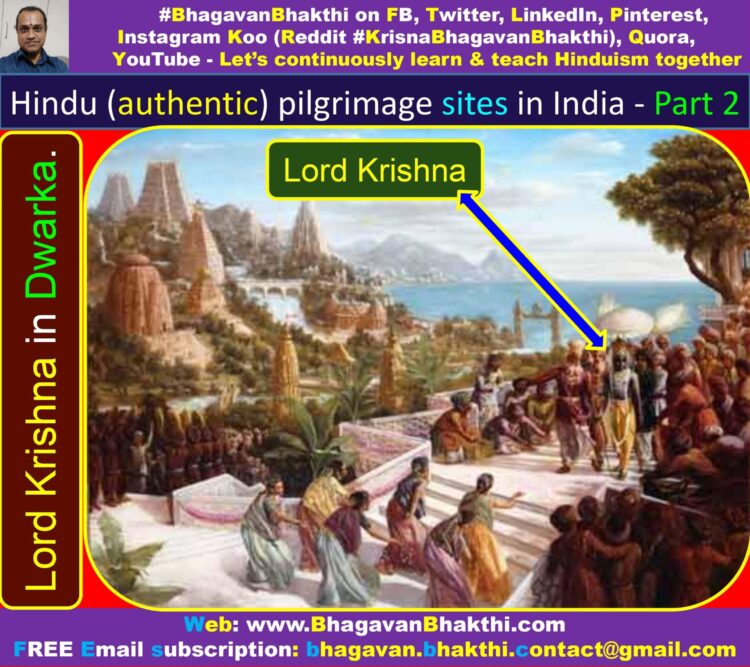
Later Lord Krishna came along with all the Yadavas to stay at Dwaraka (Dwarka) leaving Mathura.
It is also believed Dwaraka (Dwarka) town was submerged under the sea after Lord Krishna’s mission was over on earth.
Dwarkadhisha (Dwarkadhish) (Lord Krishna) temple is built in Chalukyan style of architecture.
This holy and sacred temple is 51.8 meters high.
Dwarkadhisha (Dwarkashish) (Lord Krishna) temple is also known as ‘Jagat Mandir‘.
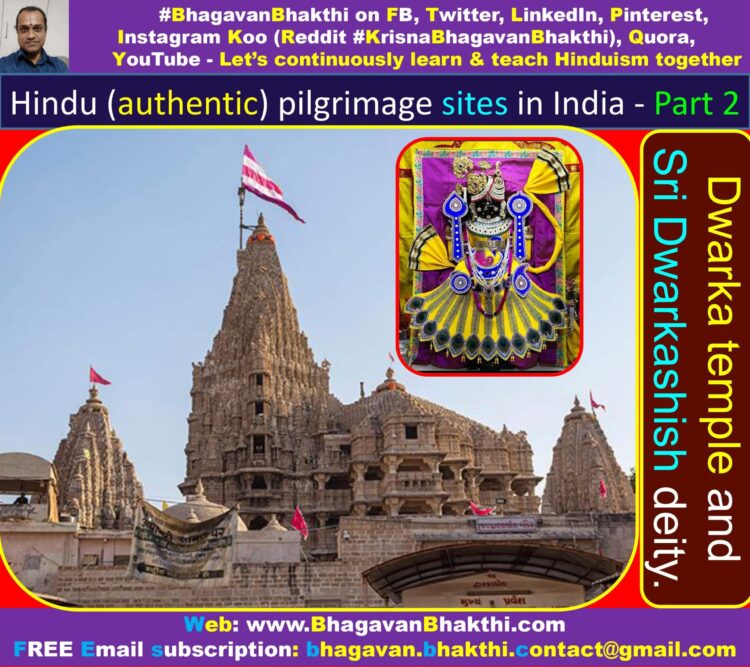
Gomati (Gomti) river : Gomati river merges with the present day Arabian sea at Dwaraka (Dwarka).
Guru Sri Vadiraja Tirtha glorifies the Gomati river as washing the feet of Lord Dwarakanatha (Dwarkanath) every day.
Note : A snana (bath) in Gomati river grants soubhagya (Divine blessings) for a woman.
Guru Sri Vadiraja Tirtha describes the same when visiting Gomati river, by comparing the confluence of the river with the ocean.
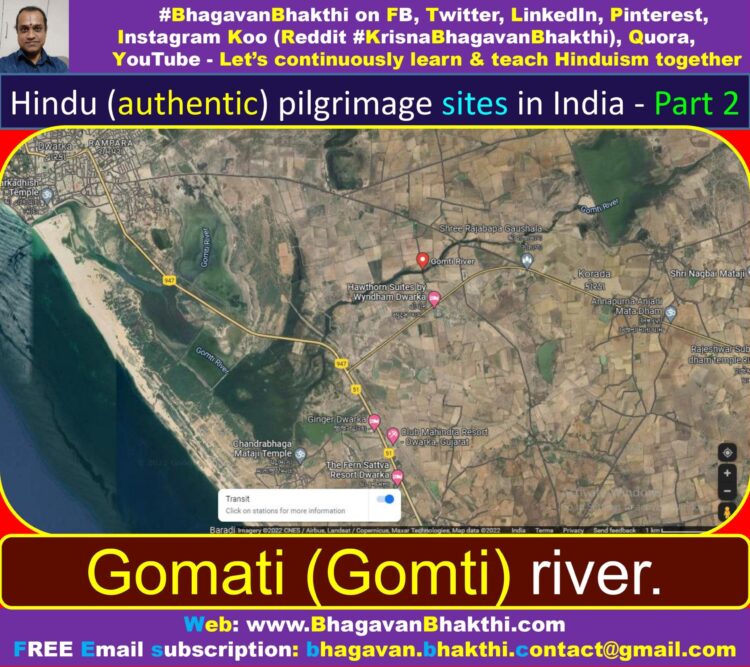
Chakra Tirtha : After Lord Krishna’s earthly mission was completed, Chakra Tirtha was not visible and must have submerged under the sea.
Chakra Tirtha is a location on the coast near Dwaraka (Dwarka).
On this coast, the special ‘Shilas’ (Divine rocks) known as ‘Chakranika’ (Chakrankita) is available here.
This stone is very pious and is worshipped by all the Vaishnavas just like Shaligrama.
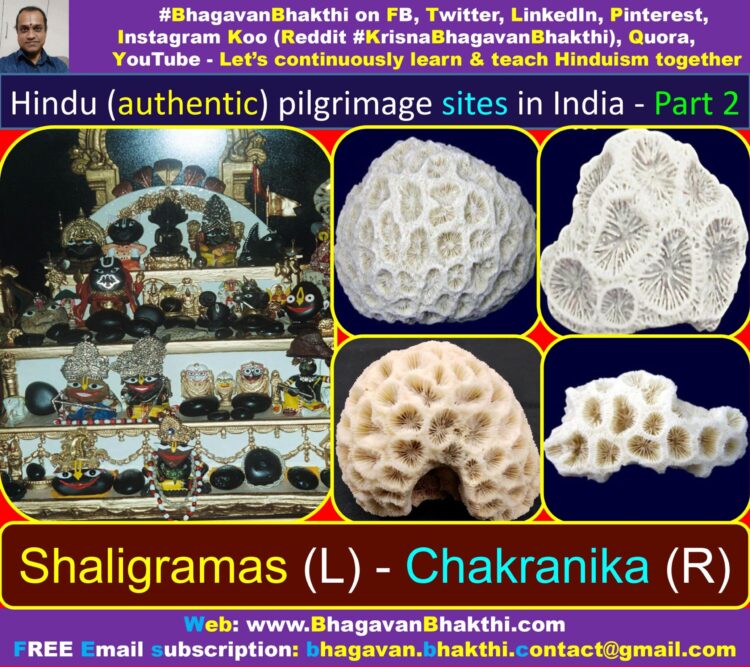
Shankodhara Tirtha : Lord Krishna killed ‘Panchajanas’ (Panchajans) entering deep into the sea.
And came out with ‘Panchajanya’ shankha to offer the Guru Pradakshina to his Guru ‘Sandipani Rishi‘.
Guru Sri Vadiraja Tirtha describes the defeat of Panchajanas and significance of ‘Panchajanya’ while visiting this place.
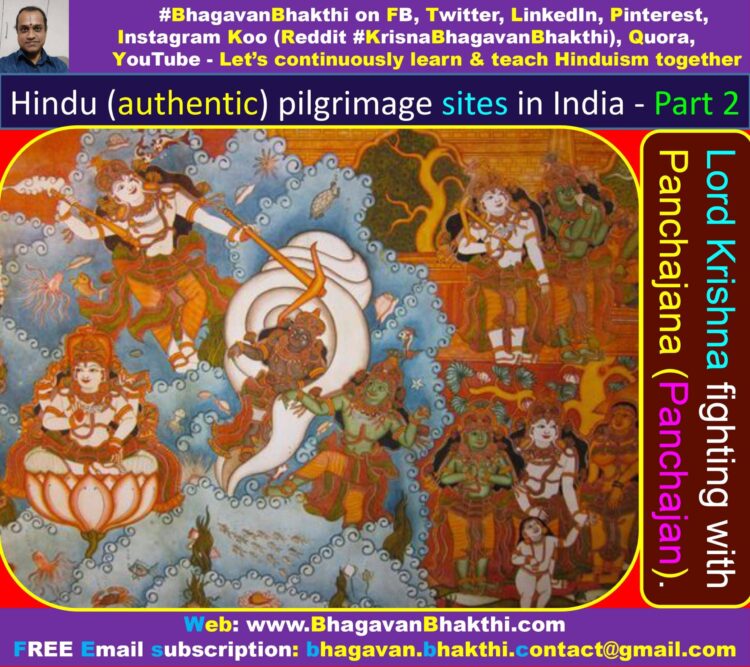
Gopi Chandana (Gopi Chandan) : Guru Sri Vadiraja Tirtha explains the greatness of ‘Gopi Chandana‘.
If one who applies the ‘Gopi Chandana’, that person becomes divinely powerful and more knowledgeable person.
Gopi Chandana when pasted on the forehead, causes the various writings of the creator Lord Brahma itself to be erased.
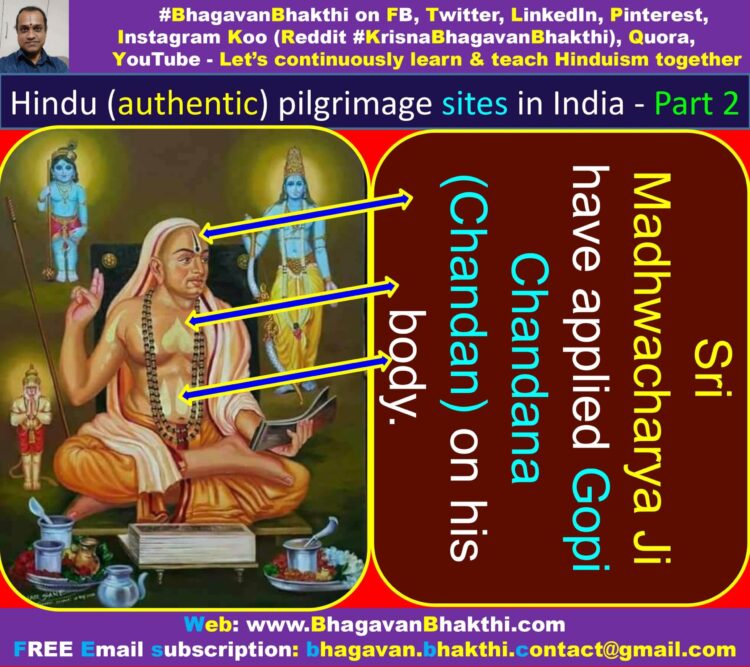
When applied as a Tilaka (Tilak) for decoration makes one a great scholar.
When adorned as a straight mark manifests as the stairs to Vaikuntha Loka and destroys the ‘taapatraya’ (Various problems).
About 20 kms from Dwaraka (Dwarka) is a place called Gopi talab (talav). It is here that Gopi Chandana is available. There is also a Lord Gopinatha (Gopinath) temple here.
Gopi Chandana is essentially the ‘mrittika’ on which Lord Krishna walked around.
Hence it is extremely pure and revered.
Note : In Dwaraka (Dwarka), the Gopi Chandana which is worn as a Vaishnava mark is available abundantly. The same is praised here by Guru Sri Vadiraja tirtha.
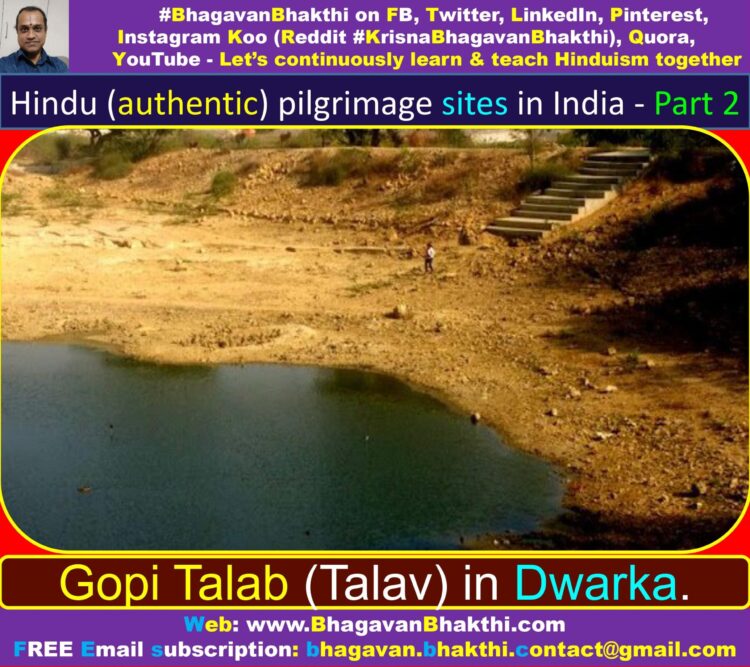
Siddhapuri (Siddhpur) and Bindu Sarovar (Lake) : Siddhapuri is 100 kms away from today’s Ahmedabad.
Lord Vishnu took the form of Lord Kapila (He was born to Maharishi Kardama and Devahuti).
Bindu Saravor (Lake) was made up of cheerful tears of Lord Kapila.
Guru Sri Vadiraja Tirtha describes Siddhapuri as offering moksha to the visitors.
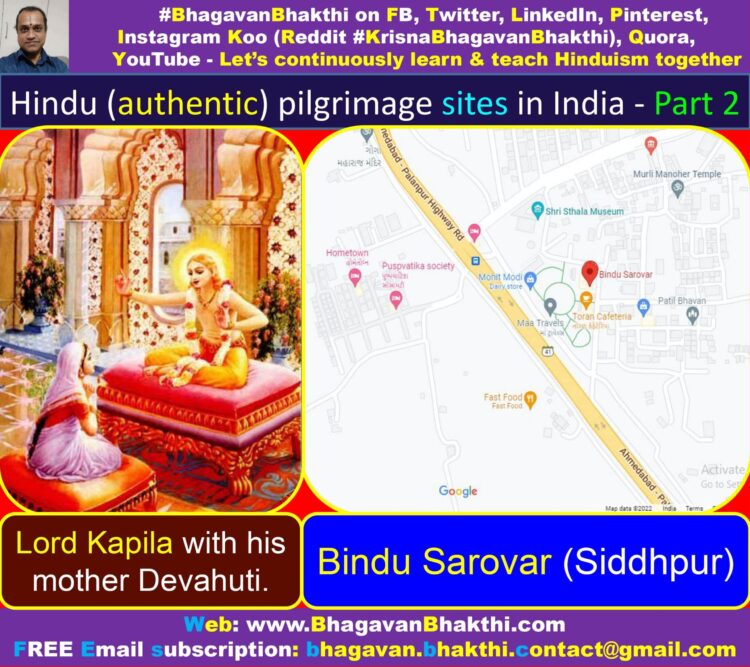
Tirtha Raja Pushkara (Tirthraj Pushkar) : Here Lord Vishnu remain as Lord Varaha after defeating the demon Hiranyaksha.
This Pushkara (Pushkar) Kshetra, is about 11 kms from today’s Ajmer in Rajasthan.
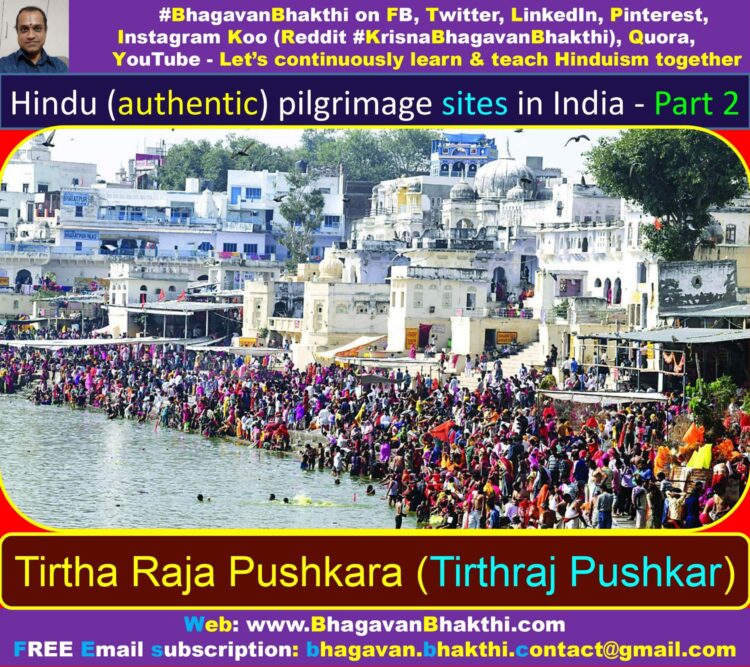
And it is one of the eight ‘Swayam Vyakta Kshetras‘ (Self manifested place).
This place has been mentioned in the the great and holy Mahabharata and also in the Padma Purana.
This place was constructed by Lord brahma.
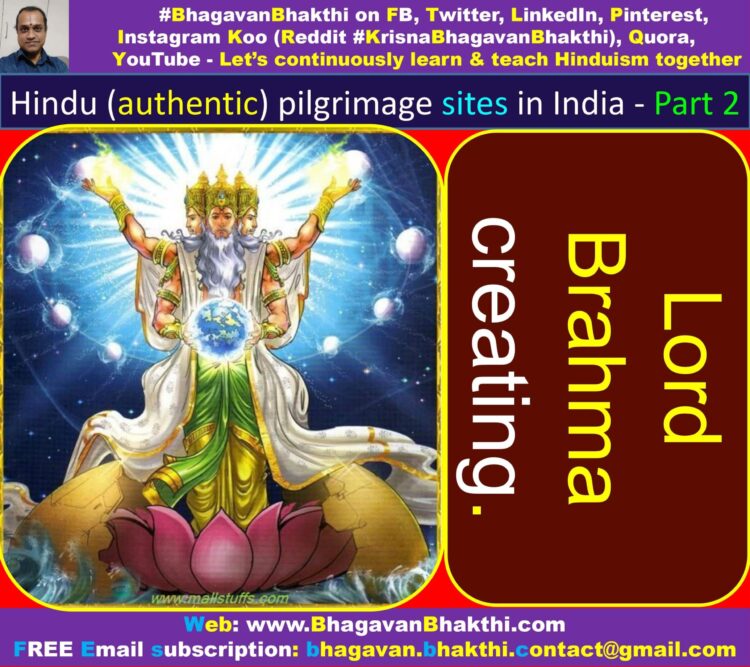
Hence Guru Sri Vadiraja Tirtha describes it as ‘Martyadushkaram’, that is, which cannot be constructed by any ordinary human.
Puranas mention that Lord Varaha, after killing the demon Hiranyaksha, entered this tirtha and went towards his abode.
It was at this very place that Lord Krishna killed the two daityas (demons) called as ‘Hamsa’ and ‘Dibika’ and also destroyed their army which was 17 akshouhini sainya in size.
According to another local legend, a demon was killing the children in this place.
Lord Brahma slayed the demon by throwing a Pushkara (Pushkar), a spring appeared hill called as Pushkara (Pushkar).

The place became famous as Pushkara (Pushkar) as it was created on the fall of Pushkara (Pushkar) (Lotus).
To watch videos on #Hinduism #Sanskrit language, SUBSCRIBE to my YouTube channel from this below link:
#BhagavanBhakthi YouTube channel
For “Hindu (authentic) pilgrimage sites in India – Part 1“, please click the below link:
Hindu (authentic) pilgrimage sites in India – Part 1
For “Hindu (authentic) pilgrimage sites in India – Part 3“, please click the below link:
Hindu (authentic) pilgrimage sites in India – Part 3
For “Hindu (authentic) pilgrimage sites in India – Part 4“, please click the below link:
Hindu (authentic) pilgrimage sites in India – Part 4
For “Hindu (authentic) pilgrimage sites in India – Part 5“, please click the below link:
Hindu (authentic) pilgrimage sites in India – Part 5
To know about “Ekadashi unknown facts” and real significances of Ekadashi fasting, kindly click the below link:
To know more about “Lord Krishna unknown facts“, please click the below link:
To know more about “Lord Vishnu unknown facts“, please click the below link:
To know more about “Lord Shiva unknown facts“, please click the below link:
Dear friends, if you need any clarifications about this post, kindly let me know, I will definitely try to answer all of them.
Also your one LIKE, one COMMENT, One Share, one SUBSCRIPTION is highly important.
This will help to know the quality of this content and also it will be helpful to know if any improvements is required for the content.
If you feel this content is useful to you and has helped you to improve your knowledge, kindly share this with your well-wishers.
Because “SHARING MEANS CARING”.
For receive FREE EMAIL SUBSCRIPTION about #BhagavanBhakthi, you can send an email to bhagavan.bhakthi.contact@gmail.com from your email ID.
NAMASTE!
Sri Gurubhyo Namaha
OM NAMO NARAYANAYA
Sri Krishnaarpanamastu
Subscribe / Follow us Share in Social Media
The information shared is of top quality which has to get appreciated at all levels. Well done…
Thank you so much for sharing this wonderful post with us.
A great post without any doubt.
I was very happy to discover this website. I want to to thank you for your time due to this fantastic read!! I definitely liked every little bit of it and i also have you book marked to check out new things on your blog.
The information shared is of top quality which has to get appreciated at all levels. Well done…
A great post without any doubt.
The information shared is of top quality which has to get appreciated at all levels. Well done!
A great post without any doubt.
The information shared is of top quality which has to get appreciated at all levels. Well done!
Thank you for sharing indeed great looking !
Thank you for sharing indeed great looking !
Thank you for your sharing. I am worried that I lack creative ideas. It is your article that makes me full of hope. Thank you.